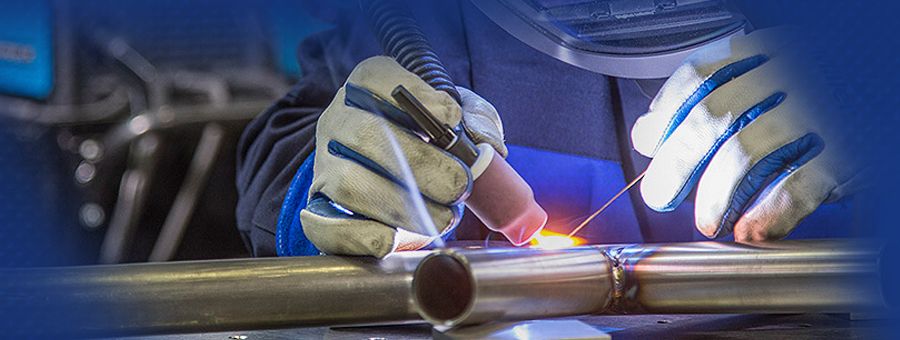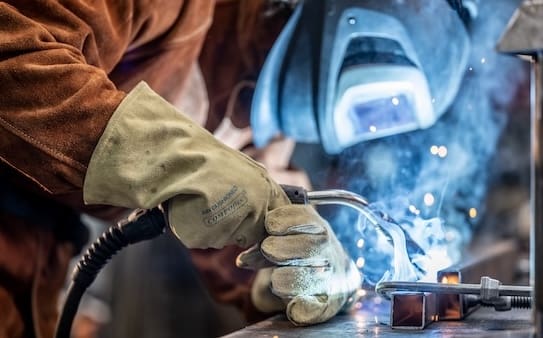Typical Welding Repair Work Issues and Exactly How to Address Them Efficiently
Welding repair services commonly encounter a variety of problems that can jeopardize the stability of the end product. Usual troubles consist of poor infiltration, porosity, and misalignment, to name a few. Each defect provides special difficulties that call for particular approaches for resolution. Comprehending these concerns is necessary for welders intending to boost their skills and results. This conversation will certainly discover these common welding fixing issues and efficient approaches to resolve them.
Poor Infiltration
Inadequate penetration takes place when the weld steel falls short to fully fuse with the base product, leading to weak joints and prospective structural failings. This problem commonly originates from inadequate heat input, wrong electrode angle, or incorrect welding speed. Welders may run into insufficient penetration due to a mistake of the needed specifications for a particular material density or kind. In addition, contamination on the base material's surface can prevent efficient bonding, intensifying the problem. To address insufficient infiltration, welders need to guarantee proper setups on their equipment and keep a clean job surface. Routine inspection of welds is recommended to recognize any type of shortages early, enabling timely corrections and the prevention of compromised architectural honesty in bonded assemblies.
Porosity
Porosity is a common flaw in bonded joints that manifests as small gas bubbles trapped within the weld metal. This flaw can endanger the stability of the weld, bring about decreased stamina and potential failing under stress and anxiety. Montana Mobile Welding and Repair Belgrade Fabrication. Porosity commonly arises from contamination, dampness, or incorrect welding techniques, which allow gases to get away right into the molten weld pool. To address porosity, welders need to guarantee correct surface area prep work, preserve a tidy working atmosphere, and utilize suitable welding specifications. In addition, choosing the right filler material and securing gas can reduce gas entrapment. Regular examination and testing of welds can help recognize porosity early, assuring timely restorative activities are taken, consequently protecting the quality and dependability of the bonded framework
Misalignment
Imbalance in welding can emerge from various variables, including incorrect configuration and thermal expansion. Recognizing the origin triggers is necessary for efficient resolution. A number of modification methods are available to realign elements and ensure structural stability.
Reasons of Imbalance
Welding imbalance typically stems from a variety of underlying issues that can endanger architectural integrity. One main cause is inappropriate fit-up of components prior to welding, which can result in voids and irregular surfaces. Variants in thermal development during the welding process can additionally result in distortion, especially if the materials being joined have various coefficients of growth. Furthermore, poor securing and fixturing might stop working to hold elements safely in position, leading to activity during welding. Inadequately kept devices, consisting of welding equipments and devices, might introduce disparities in the weld grain, additional adding to imbalance. Operator error, stemming from not enough training or experience, can additionally play a significant role in producing misaligned welds.

Adjustment Methods Readily Available
Attending to imbalance properly calls for a mix of corrective strategies customized to the specific problems handy. One typical approach is making use of jigs or fixtures to hold elements in the appropriate placement throughout welding, guaranteeing constant positioning. In addition, pre-heating the products can help in reducing distortion and improve fit-up. For significant imbalance, mechanical adjustment methods, such as using hydraulic jacks or clamps, can be utilized to fix the setting prior to welding. Post-weld heat treatment might likewise be essential to eliminate tensions triggered by imbalance. Mindful examination and change during the arrangement phase can prevent imbalance issues from coming to be considerable problems, advertising a smoother welding procedure and improving overall architectural honesty.
Distortion
Distortion is a typical challenge in welding that can arise from numerous aspects, including uneven cooling and heating. Understanding the reasons of distortion is crucial for carrying out effective prevention methods. Resolving this concern not only enhances structural honesty yet also improves the general top quality of the weld.
Root causes of Distortion
When subjected to the extreme warmth of welding, materials usually go through adjustments that can bring about distortion. This sensation largely arises from thermal expansion and contraction during the welding process. As the weld location warms up, the material broadens; upon air conditioning, it acquires, which can create internal stresses. Additionally, unequal home heating throughout a work surface can worsen these stresses, causing warping or bending. The sort of material additionally plays a considerable function; metals with differing thermal conductivity and coefficients of development might respond in a different way, bring about unpredictable distortions. Poor joint design and inadequate fixturing can contribute to imbalance throughout welding, enhancing the chance of distortion. Recognizing these reasons is essential for effective welding repair work and prevention strategies.
Avoidance Techniques
Efficient prevention techniques for distortion during welding concentrate on controlling warm input and ensuring proper joint style. Preserving a consistent heat input helps to reduce thermal expansion and tightening, which can result in distortion. Making use of methods such as preheating the work surface can additionally lower the temperature gradient, promoting uniform home heating. Furthermore, selecting suitable joint designs, such as T-joints or lap joints, can boost security and decrease stress and anxiety concentrations. Carrying out proper fixturing to secure the work surfaces in place better help in maintaining alignment during the welding process. Staggered welding sequences can disperse heat a lot more equally, stopping localized distortion. By applying these strategies, welders can considerably decrease the probability of distortion and boost the general high quality of their welds.
Breaking
Cracking is an usual problem run into in welding fixings, typically resulting from numerous factors such as inappropriate cooling prices, material option, or insufficient joint preparation. The occurrence of splits can significantly endanger the honesty of the weld, resulting in potential failings during operation. To resolve this problem, welders have to initially assess the root triggers, making certain that products are compatible and properly picked for the certain application. Additionally, controlling the cooling rate during the welding over at this website procedure is necessary; quick air conditioning can generate stress and bring about cracking. Appropriate joint layout and preparation likewise add to decreasing the risk. Carrying out these techniques can boost weld top quality and longevity, inevitably minimizing the probability of fracturing in ended up weldments.

Incomplete Combination
A considerable issue in welding fixings is insufficient fusion, which takes place when the weld metal does not adequately bond with the base product or previous weld passes - Welding. This issue can cause weaknesses in the joint, possibly jeopardizing the integrity of the welded structure. Aspects adding to insufficient fusion consist of insufficient warm input, improper welding technique, and contamination of the surface areas being signed up with. To address this problem efficiently, welders need to guarantee appropriate pre-weld cleansing and surface preparation, in addition to readjust their welding specifications to achieve ample penetration and blend. Routine inspection throughout the welding procedure can additionally assist identify incomplete combination early, permitting timely rehabilitative measures to improve the overall quality of the weld
Overheating
While welding fixings can enhance structural integrity, overheating offers a significant difficulty that can cause product destruction. Too much heat during welding can alter the mechanical homes of metals, causing reduced strength, boosted brittleness, and warping. This phenomenon is particularly important in high-stress applications where structural integrity is vital. Recognizing getting too hot can include aesthetic examinations for discoloration or distortion, along with checking temperature level during the welding procedure. To mitigate the threats related to getting too hot, welders must utilize suitable methods, such as controlling warmth input, readjusting travel speed, and utilizing suitable filler products. In addition, implementing pre- and post-weld heat treatments can help recover product buildings and improve the overall top quality of the repair service, guaranteeing long-term efficiency and safety.
Often Asked Concerns
What Are the Typical Indicators of a Welding Defect?

Just How Can I Examine My Welds for Quality?
To evaluate welds for high quality, one can use visual assessments, ultrasonic testing, and radiographic methods. Each technique ensures structural stability, recognizes issues, and validates adherence to defined criteria, ultimately enhancing the reliability of the welded joints.
What Safety Safety Measures Should I Take While Welding?
When welding, one should focus on security by using ideal individual safety check out here tools, ensuring proper ventilation, securing flammable materials away, maintaining a tidy office, and knowing environments to prevent crashes and injuries.
Can I Fix a Weld Without Redesigning the Entire Joint?
Repairing a weld without redoing the whole joint is possible, depending on the damages (Montana Mobile Welding and Repair Belgrade). Techniques such as grinding, including filler material, or using a welding procedure can efficiently attend to details problems while protecting the bordering framework
What Equipment Are Necessary for Efficient Welding Repair Works?
Important devices for reliable welding fixings include a welding machine, cord brush, mill, protective gear, clamps, and filler products. Each tool plays an important duty in making certain top quality and security throughout the fixing process. Porosity typically develops from contamination, dampness, or incorrect welding techniques, which permit gases to get away right into the liquified weld swimming pool. Poorly maintained devices, consisting of welding devices and tools, might introduce inconsistencies in the weld grain, additional contributing to misalignment. When subjected to the intense warmth of welding, materials often go through adjustments that can lead to distortion. Breaking is a typical problem run into in welding repair work, usually resulting from various aspects such as incorrect air conditioning prices, product option, or inadequate joint preparation. A considerable concern in welding repairs welding screen is incomplete blend, which takes place when the weld metal does not appropriately bond with the base product or previous weld passes.